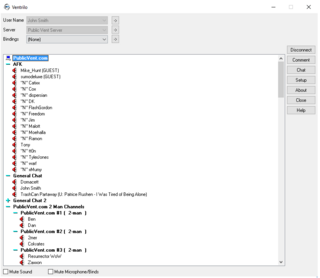The Session Initiation Protocol (SIP) is a signaling protocol used for initiating, maintaining, and terminating communication sessions that include voice, video and messaging applications. SIP is used in Internet telephony, in private IP telephone systems, as well as mobile phone calling over LTE (VoLTE).
Voice over Internet Protocol (VoIP), also called IP telephony, is a method and group of technologies for voice calls for the delivery of voice communication sessions over Internet Protocol (IP) networks, such as the Internet.
HCL Sametime Premium is a client–server application and middleware platform that provides real-time, unified communications and collaboration for enterprises. Those capabilities include presence information, enterprise instant messaging, web conferencing, community collaboration, and telephony capabilities and integration. Currently it is developed and sold by HCL Software, a division of Indian company HCL Technologies, until 2019 by the Lotus Software division of IBM.

Asterisk is a software implementation of a private branch exchange (PBX). In conjunction with suitable telephony hardware interfaces and network applications, Asterisk is used to establish and control telephone calls between telecommunication endpoints such as customary telephone sets, destinations on the public switched telephone network (PSTN) and devices or services on voice over Internet Protocol (VoIP) networks. Its name comes from the asterisk (*) symbol for a signal used in dual-tone multi-frequency (DTMF) dialing.

Ventrilo is a proprietary VoIP software that includes text chat.

A VoIP phone or IP phone uses voice over IP technologies for placing and transmitting telephone calls over an IP network, such as the Internet. This is in contrast to a standard phone which uses the traditional public switched telephone network (PSTN).
Gizmo5 was a voice over IP communications network and a proprietary freeware soft phone for that network. On November 12, 2009, Google announced that it had acquired Gizmo5. On March 4, 2011, Google announced that the service would be discontinued as of April 3, 2011.
QuteCom was a free-software SIP-compliant VoIP client developed by the QuteCom community under the GPL-2.0-or-later license. It allows users to speak to other users of SIP-compliant VoIP software at no cost. It also allows users to call landlines and cell phones, send SMS and make video calls. None of these functions are tied to a particular provider, allowing users to choose among any SIP provider.
Zfone is software for secure voice communication over the Internet (VoIP), using the ZRTP protocol. It is created by Phil Zimmermann, the creator of the PGP encryption software. Zfone works on top of existing SIP- and RTP-programs, but should work with any SIP- and RTP-compliant VoIP-program.
ZRTP is a cryptographic key-agreement protocol to negotiate the keys for encryption between two end points in a Voice over IP (VoIP) phone telephony call based on the Real-time Transport Protocol. It uses Diffie–Hellman key exchange and the Secure Real-time Transport Protocol (SRTP) for encryption. ZRTP was developed by Phil Zimmermann, with help from Bryce Wilcox-O'Hearn, Colin Plumb, Jon Callas and Alan Johnston and was submitted to the Internet Engineering Task Force (IETF) by Zimmermann, Callas and Johnston on March 5, 2006 and published on April 11, 2011 as RFC 6189.
This is a comparison of voice over IP (VoIP) software used to conduct telephone-like voice conversations across Internet Protocol (IP) based networks. For residential markets, voice over IP phone service is often cheaper than traditional public switched telephone network (PSTN) service and can remove geographic restrictions to telephone numbers, e.g., have a PSTN phone number in a New York area code ring in Tokyo.
FreeSWITCH is a free and open-source telephony software for real-time communication protocols using audio, video, text and other forms of media. The software has applications in WebRTC, voice over Internet Protocol (VoIP), video transcoding, Multipoint Control Unit (MCU) functionality and supports Session Initiation Protocol (SIP) features.

Jitsi is a collection of free and open-source multiplatform voice (VoIP), video conferencing and instant messaging applications for the Web platform, Windows, Linux, macOS, iOS and Android. The Jitsi project began with the Jitsi Desktop. With the growth of WebRTC, the project team focus shifted to the Jitsi Videobridge for allowing web-based multi-party video calling. Later the team added Jitsi Meet, a full video conferencing application that includes web, Android, and iOS clients. Jitsi also operates meet.jit.si, a version of Jitsi Meet hosted by Jitsi for free community use. Other projects include: Jigasi, lib-jitsi-meet, Jidesha, and Jitsi.

Jami is a SIP-compatible distributed peer-to-peer softphone and SIP-based instant messenger for Linux, Microsoft Windows, macOS, iOS, and Android. Jami was developed and maintained by the Canadian company Savoir-faire Linux, and with the help of a global community of users and contributors, Jami positions itself as a potential free Skype replacement.
A softphone is a software program for making telephone calls over the Internet using a general purpose computer rather than dedicated hardware. The softphone can be installed on a piece of equipment such as a desktop, mobile device, or other computer and allows the user to place and receive calls without requiring an actual telephone set. Often, a softphone is designed to behave like a traditional telephone, sometimes appearing as an image of a handset, with a display panel and buttons with which the user can interact. A softphone is usually used with a headset connected to the sound card of the PC or with a USB phone.

The 3CXPhone System is the software-based private branch exchange (PBX) phone system developed and marketed by the company, 3CX. The 3CX Phone System is based on the SIP standard and enables extensions to make calls via the public switched telephone network (PSTN) or via Voice over Internet Protocol (VoIP) services on premises, in the cloud, or via a cloud service owned and operated by the 3CX company. The 3CX Phone System is available for Windows, Linux, Raspberry Pi and supports standard SIP soft/hard phones, VoIP services, faxing, voice and web meetings, as well as traditional PSTN phone lines.
WebRTC is a free and open-source project providing web browsers and mobile applications with real-time communication (RTC) via application programming interfaces (APIs). It allows audio and video communication and streaming to work inside web pages by allowing direct peer-to-peer communication, eliminating the need to install plugins or download native apps.
Acrobits is a privately owned software development company creating VoIP Clients for mobile platforms, based in Prague, Czech Republic.
Web Call Server is unified intermedia server software developed by Flashphoner. It is a server-side platform, implemented in Java, dedicated for streaming video over wide range of communication protocols, including:










